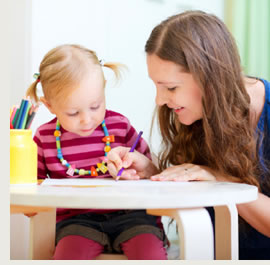|
|
||||||
|
||||||
| Au pairs | ||||||
| A very economical child care option for families needing part time child care | ||||||
|
At the same time, social change increased the number of middle class girls who needed to earn their own living, and rising educational aspirations for girls made experiencing foreign cultures and learning foreign languages more common aspirations. Au pairs became commonplace in families in the seventies, along with all the Swedish au pair jokes. It was quite de rigueur to have a "live-in girl" from another country, who performed light household chores and child care for board and lodging in a family's house, while she (it was and still is mainly females) learned the English language. Many language students and GAP year students from the UK and other English speaking countries started answering ads in The Lady for au pair posts in other European countries. What Exactly Is An Au Pair? According to the font of all knowledge, Wikipedia, the title "au pair" comes from the French term au pair, meaning "on a par" or "equal to", indicating that the relationship is intended to be one of equals: the au pair is intended to become a member of the family, albeit a temporary one, rather than a traditional domestic worker. They are not paid a salary, but given bed and board and pocket money. An au pair receives an allowance and a private room. They would generally be welcomed to eat with the family and join in usual family activities, including outings and trips and, if they're lucky, overseas holidays! However, host families normally expect to have some private time to themselves, particularly in the evenings. During this time, an au pair is generally free to have his or her own private time, watching TV, studying (as many are also students) or socialising with friends. Some au pairs are now male, but females remain the majority. Many governments impose limits as to how many hours an au pair is allowed to work. Tasks can include taking children to and from school, taking children to after-school activities, cooking, cleaning, ironing, and babysitting. Each placement varies depending on the host family. Au Pair Duties Au pairs can be expected to do a combination of child care and light housework duties. They are not responsible for housework that does not relate to the children's or communal living areas that are kept tidy by all family members. An au pair's duties may include:
Au pairs, as long as they're properly vetted for suitability and police checked, are great for families who only need part time care (before and after school for example) or for one or two days a week and can be a less costly alternative to a nanny. They still require a schedule and contract of expectations, similar to a nanny, and should only work "part time", generally around 30 hours is standard, but they become part of the family and you pay pocket money (usually around $150-200 pw). Au pairs are also great as a shared resource with another family. They do live in, but this can be at one or the other family's home depending on who has the most space. How Do You Find One? There are many ways to find an au pair from word of mouth/recommendations from friends, adverts in colleges and universities, local papers and on websites that advertise au pairs direct to the families. But just like finding a nanny, it's best to get an au pair from a registered agency, so you know they have been vetted, referenced and police checked. Many nanny agencies also provide au pair introductions. The CareforKids.com.au search for Au Pairs allows you to put in criteria such as the number of children you have, what education or qualifications you would like, language requirements and screening preferences. Of course, if your husband does have a roving eye, it's best not to hire a six-foot Swedish blond bombshell or a Brazilian beauty who does the chores in an eensy weensy teeny weeny yellow polka dot bikini, but then again, there are also male au pairs and they come in all shapes and sizes too. Bonne chance! To search for an au pair, click the button below or for more information on Au Pairs read our article here |
||||||
|
|
|||||||||

 Au Pairs have been around since World War II, when changes in social attitudes and increases in wages and taxes after the war, made traditional domestic help inaccessible to most middle class parents.
Au Pairs have been around since World War II, when changes in social attitudes and increases in wages and taxes after the war, made traditional domestic help inaccessible to most middle class parents.